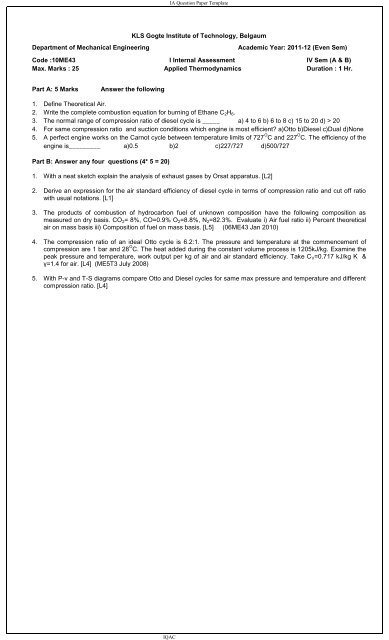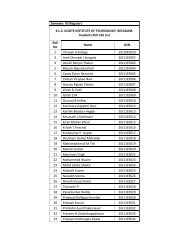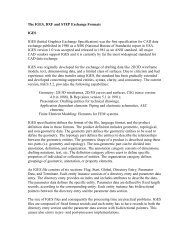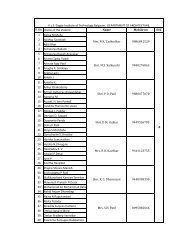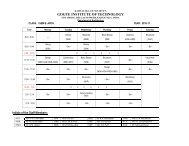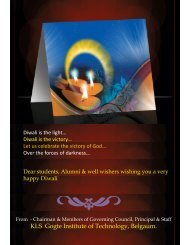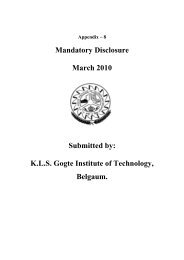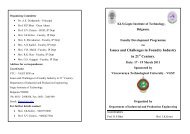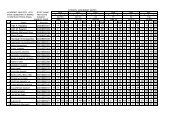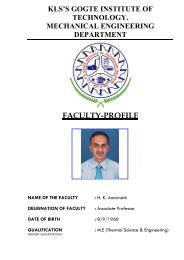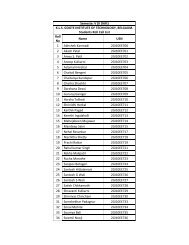A Division All Question Papers of 1st I.A. >>>>> Click here - GIT.edu
A Division All Question Papers of 1st I.A. >>>>> Click here - GIT.edu
A Division All Question Papers of 1st I.A. >>>>> Click here - GIT.edu
Create successful ePaper yourself
Turn your PDF publications into a flip-book with our unique Google optimized e-Paper software.
IA <strong>Question</strong> Paper Template<br />
IQAC<br />
KLS Gogte Institute <strong>of</strong> Technology, Belgaum<br />
Department <strong>of</strong> Mechanical Engineering<br />
Academic Year: 2011-12 (Even Sem)<br />
Code :10ME43 I Internal Assessment IV Sem (A & B)<br />
Max. Marks : 25 Applied Thermodynamics Duration : 1 Hr.<br />
Part A: 5 Marks<br />
Answer the following<br />
1. Define Theoretical Air.<br />
2. Write the complete combustion equation for burning <strong>of</strong> Ethane C 2 H 6 .<br />
3. The normal range <strong>of</strong> compression ratio <strong>of</strong> diesel cycle is _____ a) 4 to 6 b) 6 to 8 c) 15 to 20 d) > 20<br />
4. For same compression ratio and suction conditions which engine is most efficient? a)Otto b)Diesel c)Dual d)None<br />
5. A perfect engine works on the Carnot cycle between temperature limits <strong>of</strong> 727 O C and 227 O C. The efficiency <strong>of</strong> the<br />
engine is_________ a)0.5 b)2 c)227/727 d)500/727<br />
Part B: Answer any four questions (4* 5 = 20)<br />
1. With a neat sketch explain the analysis <strong>of</strong> exhaust gases by Orsat apparatus. [L2]<br />
2. Derive an expression for the air standard efficiency <strong>of</strong> diesel cycle in terms <strong>of</strong> compression ratio and cut <strong>of</strong>f ratio<br />
with usual notations. [L1]<br />
3. The products <strong>of</strong> combustion <strong>of</strong> hydrocarbon fuel <strong>of</strong> unknown composition have the following composition as<br />
measured on dry basis. CO 2 = 8%, CO=0.9% O 2 =8.8%, N 2 =82.3%. Evaluate i) Air fuel ratio ii) Percent theoretical<br />
air on mass basis iii) Composition <strong>of</strong> fuel on mass basis. [L5] (06ME43 Jan 2010)<br />
4. The compression ratio <strong>of</strong> an ideal Otto cycle is 6.2:1. The pressure and temperature at the commencement <strong>of</strong><br />
compression are 1 bar and 28 O C. The heat added during the constant volume process is 1205kJ/kg. Examine the<br />
peak pressure and temperature, work output per kg <strong>of</strong> air and air standard efficiency. Take C V =0.717 kJ/kg K &<br />
γ=1.4 for air. [L4] (ME5T3 July 2008)<br />
5. With P-v and T-S diagrams compare Otto and Diesel cycles for same max pressure and temperature and different<br />
compression ratio. [L4]
IA <strong>Question</strong> Paper Template<br />
IQAC<br />
Department <strong>of</strong> Mechanical Engineering<br />
KLS Gogte Institute <strong>of</strong> Technology, Belgaum<br />
Academic Year: 2011-12 (Even Sem)<br />
Code :10ME46B I Internal Assessment IV Sem (A & B)<br />
Max. Marks : 25 Fluid Mechanics Duration : 1 Hr.<br />
Part A: 5 Marks<br />
Answer the following<br />
6. A fluid is a substance that________<br />
a) Always expands until it fills any container b) is practically incompressible<br />
c) cannot withstand any shear force d)cannot remain at rest under the action <strong>of</strong> any shear force<br />
7. Mention the units <strong>of</strong> kinematic viscosity ________<br />
8. The center <strong>of</strong> pressure <strong>of</strong> a submerged plane surface ______<br />
a) should always coincide with centroid <strong>of</strong> the surface b) may be above or below the centroid<br />
c) cannot be above the centroid <strong>of</strong> the surface d) none <strong>of</strong> the above<br />
9. The buoyant force acting on a floating body passes through the ______<br />
a) metacentre <strong>of</strong> the body b) Center <strong>of</strong> gravity <strong>of</strong> the body<br />
c) centroid <strong>of</strong> the volume <strong>of</strong> the body d)centroid <strong>of</strong> the displaced volume<br />
10. An inverted U tube manometer is more sensitive that an upright manometer because<br />
a) Manometric fluid is lighter than working fluid b)Height <strong>of</strong> the levels is greater<br />
c) Manometric fluid is heavier than working fluid d) none <strong>of</strong> the above<br />
Part B: Answer any two full questions (10 * 2 = 20)<br />
Q1.a) Define with SI units: Specific gravity, Viscosity, Surface tension and Capillarity [L1] (4)<br />
Q1.b) A 150 mm diameter vertical cylinder rotates concentrically inside another cylinder <strong>of</strong> diameter 151 mm. both the<br />
cylinders are <strong>of</strong> 250 mm height. The space between the cylinders is filled with a liquid <strong>of</strong> viscosity 10 poise. Examine<br />
the torque required to rotate the cylinder at 100 rpm. [L4] (06ME36B July 2011) (6)<br />
Q2.a) State Pascal’s law and hydrostatic law [L1] (2)<br />
Q2.b) Derive an expression for the hydrostatic force and its location on an inclined plane surface submerged in<br />
liquid. [L3] (8)<br />
Q3.a) A triangular plate having base 5 m and altitude 4.5m is immersed in fresh water and its vertex is 2 m below the<br />
free surface <strong>of</strong> water. The surface <strong>of</strong> the plate is inclined at 30 0 to free water surface. Evaluate total pressure force on<br />
the plate and its location. [L5] (ME45 Jan 10) (5)<br />
Q3.b) A differential mercury manometer is used for measuring pressure difference between two pipes A and B. Pipe A<br />
is 500 mm above pipe B and deflection in mercury manometer is 200mm. Pressure intensity in pipe A is greater than<br />
pipe B. Pipes carry oil <strong>of</strong> specific gravity 0.90. Examine the pressure difference between the two pipes. [L4]<br />
(06ME46B June 2010)
IA <strong>Question</strong> Paper Template<br />
IQAC<br />
KLS GOGTE INSTITUTE OF TECHNOLOGY, BELGAUM.<br />
DEPARTMENT OF MECHANICAL ENGG. 4 th SEM Mech ( A&B) I A Test I<br />
Sub Metrology and Measurement Code 10ME42B Max Marks 25<br />
Metrology<br />
Q1 (i) The Fundamental Deviation for „H‟ hole is (zero / Positive / Negative / Bilateral) (02)<br />
(ii) Tolerance on only one side <strong>of</strong> the ZERO line is referred as (Unilateral / Bilateral/ zero ) tolerance<br />
Q2 Build the following dimensions using M112 set <strong>of</strong> slip gauges. Give the details <strong>of</strong> M112 set <strong>of</strong> slip gauges (i) 29.975<br />
(ii)38.4205 [ L5, Dec 2007]<br />
OR<br />
Describe with a neat sketch “International Prototype Meter”[L4] (05)<br />
Q3. Two End bars A & B <strong>of</strong> approximately 500 mm each in length are to be calibrated using standard Meter Bar. When A<br />
& B are mounted over each other and compared with standard Meter Bar it is found that the combined length <strong>of</strong> A &B<br />
together is 0.0002 mm shorter than standard Meter Bar. When compared among them selves End Bar A is found to be<br />
0.0004 mm longer than B. Establish the actual dimensions two End bars A & B[ L5, Dec 2008]<br />
OR<br />
Distinguish between End Standards and Line Standards [L4] (05)<br />
Measurement<br />
Q4 (i) Accuracy is the difference between ______ and __________ (03) (ii)<br />
Static sensitivity = --------- / _______<br />
Q5 Explain the working <strong>of</strong> “Generalised Measurement System” with block diagram taking the example <strong>of</strong> Bourdon<br />
Tube Pressure Gauge [ L2, Dec 2010]<br />
(05)<br />
Q6 Define the following terms<br />
(i)Accuracy (ii) Sensitivity (iii) Precision (iv) Threshold [ L1, Dec 2010] (05)
IA <strong>Question</strong> Paper Template<br />
IQAC<br />
KLS Gogte Institute <strong>of</strong> Technology, Belgaum<br />
Department <strong>of</strong> Mathematics Internal Assessment Test I Academic Year: 2011-12 (even semester)<br />
Subject : Engineering Mathematics – IV Code : 10MAT41 Semester : IV Branch: ALL<br />
Max. Marks : 25 Date : 20/03/2012 Duration : 1 Hr.<br />
_________________________________________________________________________________<br />
Instructions: i) Section A is compulsory and to be attempted on first page only<br />
ii) Answer any FOUR question form Section B. Each carries 5 marks<br />
_____________________________________________________________________________________________________<br />
Section A: 5 marks (Choose correct answer)<br />
dy x<br />
a) Taylor’s series <strong>of</strong> the equation e at y(0) = 0 is<br />
dx<br />
(i) 1<br />
2<br />
2<br />
2<br />
3<br />
x<br />
x<br />
x<br />
x<br />
x (ii) 1 x (iii) x (iv) 1 x <br />
2<br />
2<br />
2<br />
3<br />
dy<br />
b) Picard’s method is applicable to solve f ( x,<br />
y)<br />
if f(x, y) is …….<br />
dx<br />
(i) differentiable (ii) integrable (iii) geometrical (iv) none<br />
c) Which <strong>of</strong> the following is a step by step method<br />
(i) Milne’s (ii) Adams-Bashforth (iii) Both (iv) none<br />
d) Corrector formula in Admas-Bashforth method is<br />
h<br />
h<br />
(i) y<br />
4<br />
y3<br />
(55 f3<br />
59 f2<br />
37 f1<br />
9 f0)<br />
(ii) y<br />
4<br />
y3<br />
(9 f4<br />
19 f3<br />
5 f2<br />
f1)<br />
24<br />
24<br />
h<br />
h<br />
(iii) y<br />
4<br />
y3<br />
(55 f3<br />
59 f2<br />
37 f1<br />
9 f0)<br />
(iv) y<br />
4<br />
y3<br />
(9 f4<br />
19 f3<br />
5 f2<br />
f1)<br />
24<br />
24<br />
e) y + y + y = 0 is equivalent to a set <strong>of</strong> two first order differential equations ……<br />
(i) y = x and x + x + y = 0 (ii) y = z and z + z + y = 0<br />
(iii) y = z and z + z + z = 0 (iv) y = z and y – y – y = 0<br />
Section B: 20 marks<br />
1. Employ Taylor’s series method to obtain y(0.2) from the differential equation<br />
dy = 2y + 3e x , y (0) = 0. [L3]<br />
dx<br />
dy<br />
2. Using modified Euler’s method find y at x = 0.1 given = x 2 + y, y(0) = 1 (Jan 2010) [L3]<br />
dx<br />
3. Using Runge-Kutta method find approximate value <strong>of</strong> y for x = 0.8 given<br />
dy<br />
dx<br />
x<br />
y , y = 0.41 when x = 0.4. [L3]<br />
4. Employ Milne’s method to solve y = x – y 2 at x = 0.8 given that<br />
y(0) = 0, y(0.2) = 0.02, y(0.4) = 0.0795, y(0.6) = 0.1762.<br />
5. Evaluate y and z at x = 0.1 by Picard’s method from y(0) = 2, z(0) = 1 and<br />
dy = x + z,<br />
dx<br />
dz = x – y 2 .<br />
dx<br />
6. Solve by Runge – Kutta method at x = 0.2 given y = x(y ) 2 – y 2 and x = 0, y = 1, y = 0. [L3]<br />
[L3]<br />
[L5]
IA <strong>Question</strong> Paper Template<br />
IQAC<br />
KLS Gogte Institute <strong>of</strong> Technology, Belgaum<br />
Department <strong>of</strong> Mechanical Engineering Academic Year: 2011-12<br />
Internal Assessment Test I<br />
Subject: Manufacturing Process-II<br />
Code: 10EME45<br />
Semester: IV Marks: 25 <strong>Division</strong>s: A & B Faculty: ASD/AVK/SJP<br />
Note: Part A is compulsory. Answer any FOUR in part B<br />
A. Answer the following (5 × 1 mark = 5 marks)<br />
1. A ductile work material usually produces _________ chips, while a brittle work material<br />
produces _________ chips.<br />
2. During a machining operation, the tool life equation was found to be VT 0.39 = 150. If the<br />
cutting speed is 25m/min, then the tool life is __________ min.<br />
3. The Ernst-Merchant’s solution with usual notation is ______________<br />
4.In facing operation on a lathe a cylindrical surface is produced. (True/False)<br />
5. In a planer, the primary (or cutting) motion is provided to:<br />
a) The tool b) The work piece c) Both work piece and tool d) None<br />
B. Answer any four <strong>of</strong> the following (4 × 5 mark = 20marks)<br />
1. Illustrate the different types <strong>of</strong> chips produced in metal cutting. Also distinguish between<br />
the machining conditions during which these chips are produced.<br />
[L3,4]<br />
2. Draw the Merchant’s circle indicating all the force components and also state the expressions<br />
for the force components Fs, Fn, F, N and µ (with usual notations).<br />
[L1,3]<br />
3.With a simple sketch, describe the working <strong>of</strong> the turret indexing mechanism <strong>of</strong> a Capstan lathe.<br />
[L3,4]<br />
4. With a neat sketch describe the working <strong>of</strong> a hydraulic shaper mechanism. [L3,4]<br />
5. In an orthogonal cutting operation on a material with yield strength <strong>of</strong> 300 N/mm 2 , the following data are<br />
obtained:<br />
Rake angle <strong>of</strong> the tool = 15degrees<br />
Uncut chip thickness= 0.25 mm<br />
Width <strong>of</strong> chip= 2 mm<br />
Chip thickness ratio = 0.46<br />
Friction angle = 40degrees.<br />
Estimate the shear angle, the cutting force component and the resultant force on the tool. [L5]<br />
6.Estimate the machining time required to machine 5mm thick layer from a work piece <strong>of</strong><br />
200mm(wide) × 400mm (length) × 50mm (thick) MS material. The available stroke rates are 10, 20,40 and 8<br />
0 strokes/min. The feed was considered to be 0.28mm/stroke. The depth <strong>of</strong> cut was<br />
given as 1mm during each cut. Consider cutting speed 30 m/min and ratio <strong>of</strong> return stroke time<br />
to cutting stroke time as 2:3. Assume clearance <strong>of</strong> 30mm at each end <strong>of</strong> the stroke. Also<br />
determine material removal rate (MRR).<br />
[L5]<br />
------------- Good Luck! ---------------


